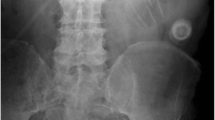Abstract
Gallstone ileus is a rare etiology for bowel obstruction that disproportionately affects elderly women. Symptoms are often subacute, making it difficult to diagnose. It results in high morbidity and mortality. A large gallstone, typically >2.5 cm, passes through a biliary-enteric fistula and becomes impacted in the intestine, causing a bowel obstruction. The most frequent site of impaction is the terminal ileum, as it is the narrowest part of the small intestine. Diagnosis is best made by computed tomography and treatment is surgical.
Access provided by Autonomous University of Puebla. Download chapter PDF
Similar content being viewed by others
Keywords
FormalPara Key Concepts-
Gallstone ileus is a rare etiology for bowel obstruction that disproportionately affects elderly women.
-
Patients often present with a subacute onset of vague symptoms, making diagnosis difficult.
-
Gallstone ileus is caused by a large gallstone, typically >2.5 cm, which passes through a biliary-enteric fistula and impacts in the bowel.
-
Diagnosis is best made by CT and treatment is surgical.
-
Mortality is ~30%.
Gallstone ileus, a mechanical bowel obstruction due to an intraluminal ectopic gallstone, is a rare cause of bowel obstruction that is highly morbid and often difficult to diagnose [1]. Recent literature shows that less than 1% of all mechanical bowel obstructions in the United States result from gallstone impaction, although prior research had suggested a frequency as high as 5% [1]. Older women are most typically affected, with a female to male ratio of 6:1. Patients are typically over 60 years old, with most patients in their 70s [1, 2]. Mortality had been reported as high as 60% but more recently has been estimated at 30% [1]. This decrease in mortality may be due to earlier detection and intervention, [1] although patients often present with subacute nonspecific symptoms that make diagnosis difficult. The mean time from symptom onset to diagnosis is 4 days.
The etiology of gallstone ileus is complex. Chronic inflammation of the gallbladder leads to local irritation of the abdominal viscera. This gallbladder and intestinal inflammation, combined with pressure necrosis from a large gallstone pressing against the gallbladder wall, eventually leads to formation of a fistula between the gallbladder and the intestine. If the gallstone passes through this fistula into the gastrointestinal tract and becomes impacted, it causes a gallstone ileus [3].
Most often, the fistula occurs between the gallbladder and the duodenum given their close proximity. However, the fistula can form between the gallbladder and any other portion of the GI tract, including the stomach and colon, with the former leading to Bouveret’s syndrome, which is a gastric outlet obstruction from an impacted gallstone [3].
The most common sites of obstruction are in the terminal ileum and at the ileocecal valve, which are the narrowest segments of intestine. Impactions also occur at sites of pre-existing stricture.
The majority of cases are caused by gallstones greater than 2.5 cm, with large gallstones (>5 cm) especially likely to become impacted and not spontaneously pass [3].
The most reliable means for diagnosing a gallstone ileus is computerized tomography (CT), which outperforms both plain films and ultrasound and has a 93% sensitivity [3, 4]. The classic radiographic findings of pneumobilia, ectopic stone, and obstructed bowel form Rigler’s triad, which is found in 15% of abdominal plain films of gallstone ileus and 78% of CTs [2, 4]. Abdominal ultrasonography may show the impacted stone and demonstrate the location of the fistula, but it provides less information than CT. Ultrasound is not the imaging of choice for gallstone ileus [4].
Figure 61.1 shows a gallstone ileus visualized by CT
Timely surgical consultation for stone removal is necessary for patients with suspected or confirmed gallstone ileus. While small gallstones may pass spontaneously, stones larger than 2.5 cm are less likely to pass and more likely to result in obstruction, requiring removal. Surgical intervention may consist of simple enterolithotomy or an enterolithotomy and fistula repair [3,4,5]. Less invasive procedures such as endoscopic retrieval of ectopic gallstones have been performed successfully and may become the treatment of choice in stable, nontoxic patients [3].
-
Gallstone ileus – causes, symptoms, diagnosis, treatment & pathology. YouTube. Oct 2016. https://www.youtube.com/watch?v=96Cj6SWAOjM
-
Gallstone ileus. Emergency Physicians Monthly. May 2012. http://epmonthly.com/article/gallstone-ileus/
-
Gallstone ileus. Radiopaedia. https://radiopaedia.org/articles/gallstone-ileus
References
Halabi WJ, Kang CY, Ketana N, et al. Surgery for gallstone ileus. Ann Surg. 2014;259(2):329–35. https://doi.org/10.1097/SLA.0b013e31827eefed.
Lassandro F, Gagliardi N, Scuderi M, Pinto A, Gatta G, Mazzeo R. Gallstone ileus analysis of radiological findings in 27 patients. Eur J Radiol. 2004;50(1):23–9. https://doi.org/10.1016/j.ejrad.2003.11.011.
Nuño-Guzmán CM, Marín-Contreras ME, Figueroa-Sánchez M, Corona JL. Gallstone ileus, clinical presentation, diagnostic and treatment approach. World J Gastrointest Surg. 2016;8(1):65–76. https://doi.org/10.4240/wjgs.v8.i1.65.
Ayantunde AA, Agrawal A. Gallstone ileus: diagnosis and management. World J Surg. 2007;31(6):1292–7. https://doi.org/10.1007/s00268-007-9011-9.
Ravikumar R, Williams JG. The operative management of gallstone ileus. Ann R Coll Surg Engl. 2010;92(4):279–81. https://doi.org/10.1308/003588410X12664192076377.
Author information
Authors and Affiliations
Editor information
Editors and Affiliations
Rights and permissions
Copyright information
© 2019 Springer Nature Switzerland AG
About this chapter
Cite this chapter
Sloane, B., Wu, A. (2019). What Is Gallstone Ileus and What Are Its Implications?. In: Graham, A., Carlberg, D.J. (eds) Gastrointestinal Emergencies. Springer, Cham. https://doi.org/10.1007/978-3-319-98343-1_61
Download citation
DOI: https://doi.org/10.1007/978-3-319-98343-1_61
Published:
Publisher Name: Springer, Cham
Print ISBN: 978-3-319-98342-4
Online ISBN: 978-3-319-98343-1
eBook Packages: MedicineMedicine (R0)





